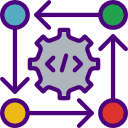Low-code development has revolutionized how businesses and individual developers build and launch applications, enabling them to move from concept to deployment with unprecedented speed. By minimizing the need for extensive hand-coding and streamlining workflows, low-code platforms make app development more accessible, collaborative, and efficient. Explore how these innovative tools empower organizations to accelerate digital transformation and respond rapidly to evolving business needs.

Democratizing Application Development
Low-code tools have unlocked application development for a wider range of users, making it possible for those without deep coding expertise to participate meaningfully in building business solutions. This democratization of development leads to greater innovation within organizations, as subject matter experts can collaborate directly with IT. By reducing reliance on specialized developers, companies can tap into new ideas from diverse teams and iterate on solutions quickly to meet real-world demands.

Enabling Faster Go-to-Market Strategies
The agility provided by low-code platforms means businesses can bring new products and services to market with remarkable speed. Instead of waiting for lengthy coding cycles, teams can prototype, test, and launch applications in a fraction of the time. This rapid turnaround is crucial for staying ahead in competitive markets where first-mover advantage and responsiveness to customer feedback are key drivers of success. Low-code development empowers organizations to seize opportunities without being held back by lengthy development pipelines.
The Power Behind Leading Low-Code Platforms
Simplified Visual Development Environments
Leading low-code tools provide intuitive drag-and-drop interfaces and visual modeling environments that simplify the development process. These environments allow users to assemble UIs, create workflows, and configure business logic without writing significant amounts of code. Not only does this make application development approachable for non-developers, but it also speeds up development for professionals by reducing setup time and eliminating repetitive coding tasks. This visual approach fosters greater collaboration and accelerates project timelines from inception to deployment.
End-to-End Lifecycle Management
Comprehensive lifecycle management features are integral to the top low-code platforms. These capabilities enable teams to oversee every stage of application development, from initial design and testing to deployment and ongoing maintenance. Built-in tools for version control, testing, and monitoring help ensure that applications remain reliable and up-to-date. By handling project management within the same environment, organizations minimize potential for miscommunication or errors, creating a cohesive path from idea to production.
Robust Security and Governance Controls
Security is paramount when building applications that handle critical business processes or sensitive data. Leading low-code platforms embed strong security practices into every layer of the development process, supporting authentication, authorization, and compliance standards. Governance controls allow IT departments to set policies, manage user access, and monitor activity, ensuring applications remain secure and regulations are met. These measures permit organizations to innovate quickly without compromising on security, compliance, or data integrity.

Application Scenarios for Low-Code Development Tools
Departments across organizational structures, such as HR, finance, and marketing, often face unique workflow challenges that off-the-shelf software cannot address. Low-code tools enable these departments to design and implement tailored applications that fit their precise requirements, from onboarding automation to expense approvals and campaign management. These custom solutions improve operational efficiency and user satisfaction by closing gaps left by generic software and reducing reliance on time-consuming manual work.
Customer expectations for seamless digital experiences have never been higher, and low-code development platforms make it feasible to deliver these experiences at scale. Businesses can utilize low-code tools to quickly develop portals, mobile apps, service platforms, and customer support solutions that are visually appealing and functionally rich. By enabling continuous iteration and integration with back-end systems, organizations can rapidly respond to user feedback, launch new features, and differentiate themselves in crowded markets.
Many organizations rely on legacy applications that no longer align with modern business needs. Low-code platforms offer efficient pathways to modernize these systems by enabling gradual transitions, enhancing functionality, and integrating with cloud services. Instead of costly rewrites, teams can use low-code solutions to incrementally upgrade outdated applications, improving performance and user experience without major business disruption. This modernization approach extends the lifespan of critical systems and supports an ongoing digital transformation journey.
Join our mailing list
